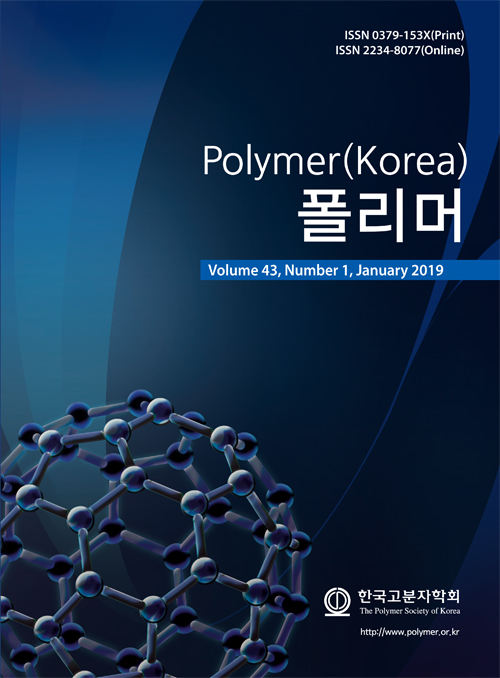- Effect of Sulfur Diradicals on the Rheological Properties of Polycarbonate, Poly(styrene-co-acrylonitrile) and Polystyrene
Department of Chemical Engineering, Dankook University, 152 Jukjeon-ro, Yongin-si, Gyeonggi 16890, Korea
*Department of Creative Convergent Manufacturing Engineering, Dankook University, 152 Jukjeon-ro, Yongin-si, Gyeonggi 16890, Korea- 황 이중라디칼이 Polycarbonate, Poly(styrene-co-acrylonitrile), Polystyrene의 유변물성에 미치는 영향
단국대학교 화학공학과, *단국대학교 창의융합제조공학과
The rheological properties of polycarbonate (PC), poly(styrene-co-acrylonitrile) (SAN), and polystyrene (PS) were investigated by introducing sulfur during the sonication of polymer solutions. It was found that the ring of sulfur was opened by the cavitation of ultrasound, producing the sulfur diradicals. These radicals were coupled with the macroradicals, which led to the remarkable changes in the rheological properties of the polymer. Although the melt viscosities of each polymer were increased or decreased depending on the sonication times, the shear sensitivities of PC, SAN, and PS were consistently increased and the Cole-Cole plot of the modified polymer showed higher elastic moduli at the same loss moduli of the pure resin. In the stress relaxation behavior, the relaxation time of each polymer was increased after the modification. The observed rheological properties were explained in relation to the structural variation of polymer chain and a plausible mechanism for the branched structure was proposed along with the FTIR analysis.
Polycarbonate(PC), poly(styrene-co-acrylonitrile)(SAN), 그리고 polystyrene(PS) 용액을 고강도 초음파로 가진하는 과정에 황을 도입하여 각 고분자의 유변 물성 변화를 조사하였다. 고리구조를 가지는 황 분자들은 초음파의 동공현상으로 인하여 고리가 열려 이중 라디칼로 변환되었고, 고분자 라디칼들과의 결합 반응을 통하여 고분자의 유변물성을 변화시켰다. 가진 시간에 따른 PC, SAN, PS의 용융 점도는 순수한 상태에 비하여 증가되거나 감소되는 특징을 나타내었으나, 각 수지의 전단 담화 경향이 증가되었고 Cole-Cole plot에서는 순수한 고분자의 동일한 점성대비 높은 탄성을 나타내었다. 응력 완화의 거동에서도 개질된 고분자 완화 시간이 증가된 것으로 확인되었다. 황과 초음파에 의하여 나타난 유변 물성의 변화를 고분자의 사슬 구조 변환과 연관지어 해석하였고, FTIR 분석과 함께 달성 가능한 가지구조의 메커니즘을 제시하였다.
Keywords: sulfur, polycarbonate, poly(styrene-co-acrylonitrile), polystyrene, rheological properties
- Polymer(Korea) 폴리머
- Frequency : Bimonthly(odd)
ISSN 0379-153X(Print)
ISSN 2234-8077(Online)
Abbr. Polym. Korea - 2023 Impact Factor : 0.4
- Indexed in SCIE
 This Article
This Article
-
2019; 43(1): 85-91
Published online Jan 25, 2019
- 10.7317/pk.2019.43.1.85
- Received on Jul 27, 2018
- Revised on Aug 31, 2018
- Accepted on Aug 31, 2018
 Correspondence to
Correspondence to
- Hyungsu Kim
-
Department of Chemical Engineering, Dankook University, 152 Jukjeon-ro, Yongin-si, Gyeonggi 16890, Korea
- E-mail: hkim@dankook.ac.kr










 Copyright(c) The Polymer Society of Korea. All right reserved.
Copyright(c) The Polymer Society of Korea. All right reserved.